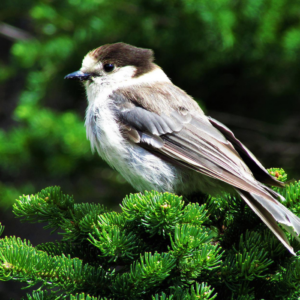Get To Know This Year’s Featured World Migratory Bird Day Species: Osprey

Vital Signs
Common name: Osprey
Latin name: Pandion haliaetus
Range: During the summer months, the osprey’s breeding grounds span parts of Alaska and the northern United States, as well as all Canadian provinces and territories except for Nunavut, where it is on the edge of its breeding range. When fall arrives, ospreys migrate to the southern United States, Mexico, Central America and the northern half of South America, where it occupies large wetlands and river systems.1
Average Lifespan: 15 to 25 years2
Size: Length of 54 to 58 cm with a wingspan of 150 to 180 cm, typically weighs 1.4 to 2 kilograms2
Population estimate: 50,000 to 500,000 in Canada1
The Facts
The osprey is a large hawk with relatively long and narrow wings with a bend at the wrist that gives this bird a distinctive shape. Ospreys live and hunt around water. The osprey has a mix of white and brown feathers, the underside of its body and wings are mostly white, with a few brown spots, and the top of its wings are mostly brown. The white crown and throat divided by a heavy brown eye line makes an unmistakable facial pattern. The sexes appear nearly identical, though the male is smaller, as is the case with most raptors.2
The osprey is well known for its ability to catch fish. It will circle a body of water looking for a fish to catch, occasionally hovering in a stationary position before diving into the water to grab the fish with its claws. The osprey has a reversible outer toe and barbed feet pads to secure its slippery prey as it emerges from the water. Their dives are usually successful 25% to 70% of the time, and so they eat live fish almost exclusively.2
Always close to water, most osprey nests are near the top of large trees. In the absence of large trees, they often make their nests on built structures like utility poles or cell towers. The female lays 2 to 4 eggs per year that take, on average, 38 days to hatch. Once hatched, the young osprey learns to fly after about 51 to 54 days.3
The Story
The osprey is considered to be a species at low risk of becoming endangered in Canada. Like many water-loving birds, they faced a major decline in their numbers in the 1950s to 1970s due to the widespread use of harmful pesticides, especially DDT. In addition, they have historically been at a high risk of being shot while at their wintering grounds in South America. Ospreys often hunt at aquaculture facilities in South America and have often been shot by workers trying to protect their fish. Today the regulations to protect ospreys are much stricter, and that, combined with the restrictions on harmful pesticide use, has led to a 200% increase in Osprey numbers in Canada since the 1970s.1
What you can do
Osprey is a magnificent bird to observe. From their spectacular plunges into water to fish, to the loud ringing call of a mated pair near the nest site, there is no doubt that the osprey is an attention grabber! The current population is stable or even growing in Canada, attesting to concerted conservation efforts to recover this and other species, in particular by banning certain pesticides and protecting them from persecution. However, like many different species of aquatic birds, threats to aquatic ecosystems like droughts and water pollution can negatively affect prey populations and lead to a decrease in osprey numbers. In addition, due to some forestry practices that lead to the removal of large trees, the osprey is increasingly reliant on built structures for nesting. Unfortunately, adult ospreys sometimes incorporate different plastics in their nest that can end up entangling a chick’s foot and injure it. Due to this, they are one of the species that are most affected by plastic pollution. Canada has identified the osprey as a priority for conservation and stewardship strategies in the hopes of maintaining their current numbers.1
All things considered, advocating for the conservation of wetlands in Canada, a reduction in single-use plastics, and conserving nature, in general, are great ways you can help to support the osprey.
You can also get involved with a local Bird Team in your community to work towards becoming Bird Friendly City Certified or host and participate in an upcoming World Migratory Bird Day event near you! You can also contact your City Council and urge them to join cities like Vaughan, Barrie, and Vancouver, to proclaim their support of World Migratory Bird Day.
Sources:
1 Canadian Wildlife Service Waterfowl Committee. 2015. Osprey (Pandion haliaetus). https://wildlife-species.canada.ca/bird-status/oiseau-bird-eng.aspx?sY=2019&sL=e&sM=a&sB=OSPR
2 The Cornell Lab. All About Birds, Osprey. https://www.allaboutbirds.org/guide/Osprey/overview
3 Audubon. Guide to North American Birds, Osprey. https://www.audubon.org/field-guide/bird/osprey
This project was undertaken with the financial support of the Government of Canada through the federal Department of Environment and Climate Change.
Ce projet a été réalisé avec l’appui financier du gouvernement du Canada agissant par l’entremise du ministère fédéral de l’Environnement et du Changement climatique.




